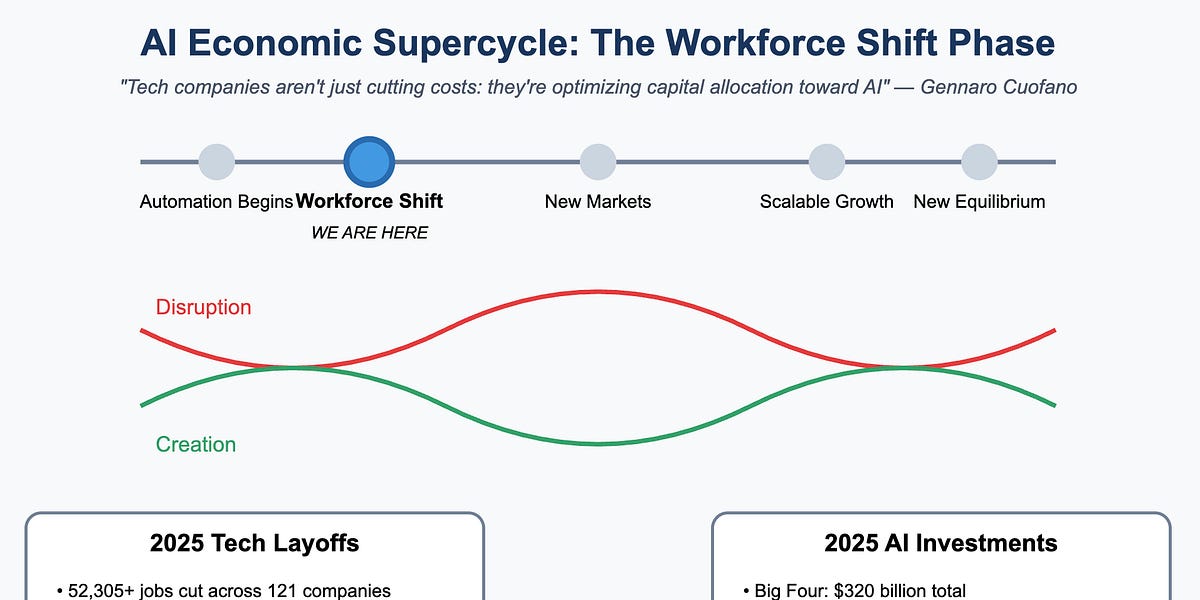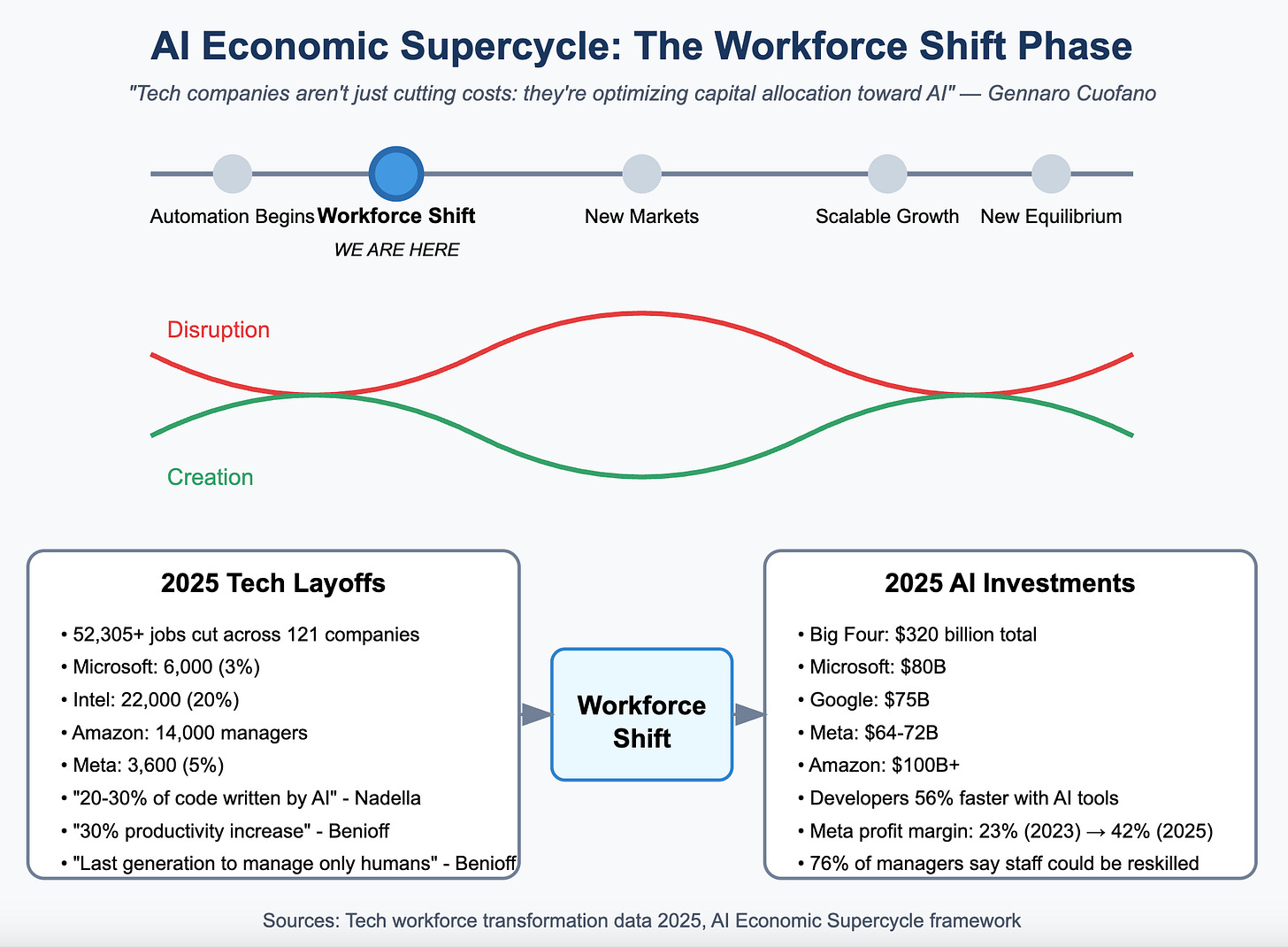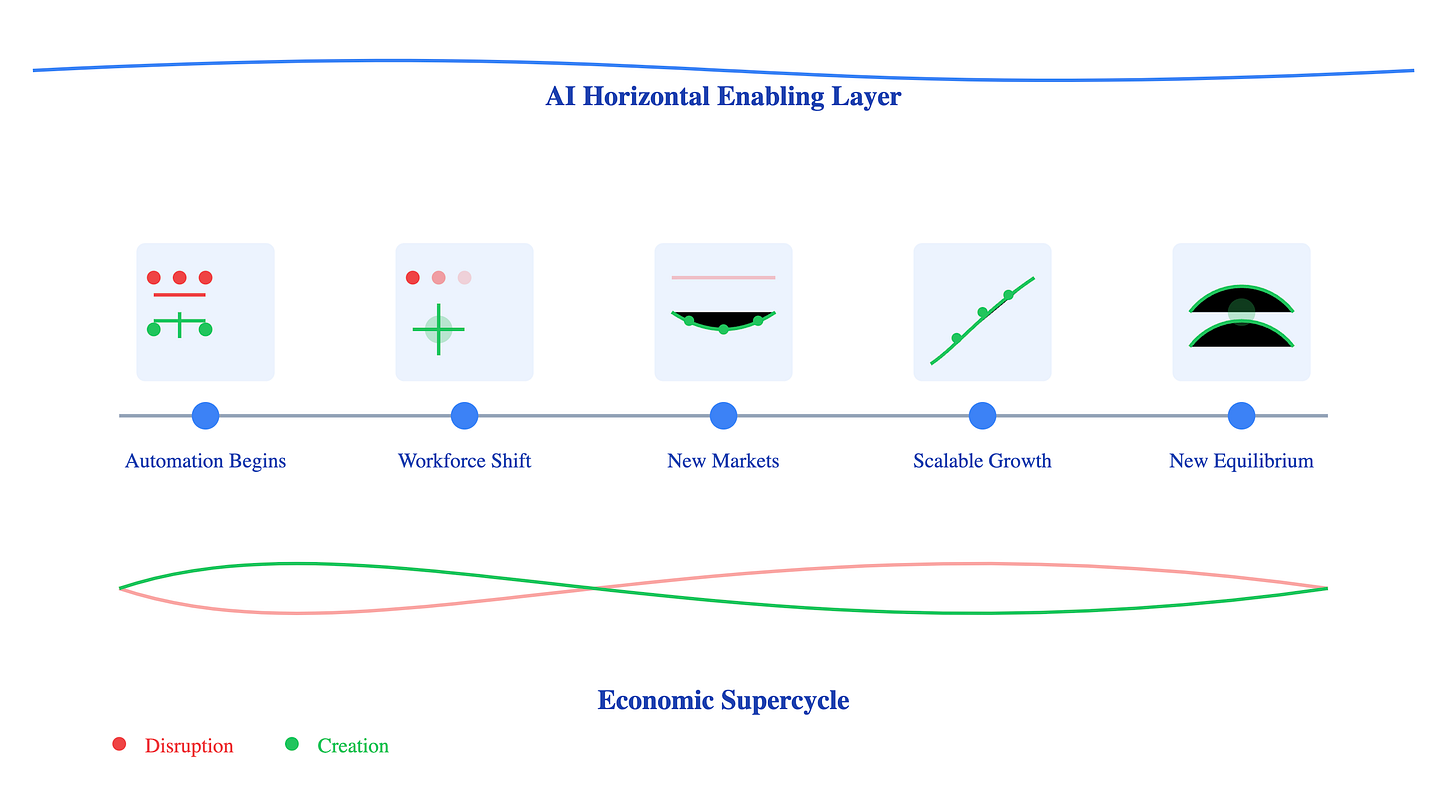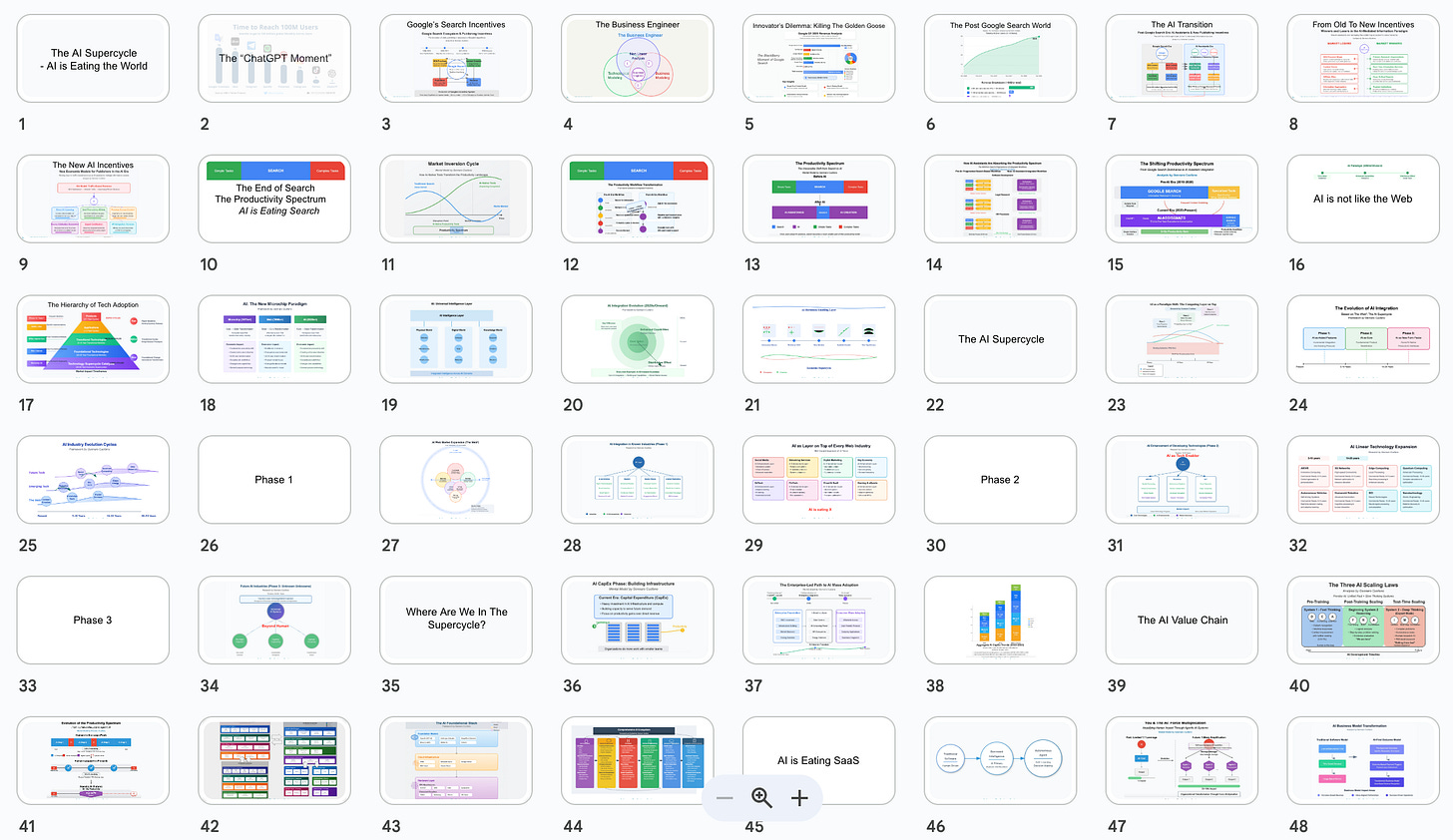
The current workforce transformation represents a pivotal phase in the broader AI Economic Supercycle, specifically the “Workforce Shift” stage identified in the AI Horizontal Enabling Layer framework I’ve talked about last year.
With over 52,000 tech jobs cut by mid-2025 while the “Big Four” tech companies simultaneously invested $320 billion in AI infrastructure, we are witnessing a strategic resource reallocation rather than simple cost-cutting.
This report analyzes the workforce shift pattern as a natural progression in the AI-driven economic transformation cycle, examining its causes, patterns, and strategic implications for businesses and policymakers.
And in the end, a focused analysis on how to start the reskilling process as a professional, to thrive in a market, which is quite challenging for many at the moment.
We’re all navigating this together, so I hope this piece can help you make sense on what to do next.
The AI Economic Supercycle represents a fundamental, multi-decade transformation of the global economy.
Unlike previous technological revolutions that primarily created informational layers (like the internet), AI establishes an intelligence layer that transforms core business value propositions.
This supercycle is expected to mature over 30-50 years, similar to how the microchip revolution reshaped industries across generations.
The AI Horizontal Enabling Layer framework identifies five key phases of this economic transformation:
-
Automation Begins: Initial AI integration focuses on automating routine tasks, with red indicators of disruption outweighing green creation signals (past three years).
-
Workforce Shift: A strategic reallocation of resources from traditional human capital toward AI-augmented productivity, with workforce rebalancing across industries (Now).
-
New Markets: Emergence of novel business models and opportunities enabled by AI capabilities.
-
Scalable Growth: Accelerated economic expansion as AI applications mature and scale across sectors.
-
New Equilibrium: A transformed economy where AI and human capabilities reach an optimized balance.
We are currently witnessing the acceleration of the “Workforce Shift” phase, characterized by simultaneous job reductions and massive AI investments.
This year has definitely been the year of re-orgs for many tech players, and we can expect this to happen to all other verticals, in the next 2-3 years.
So better to understand now the transition we’re living in tech, to anticipate what will happen next in all the other verticals (finance, law, health, HR and more).
The 2025 tech industry layoffs provide compelling evidence of this transformation phase:
-
Scale: 52,305+ tech employees laid off across 121 companies by mid-May 2025, with projections suggesting nearly 190,972 by year-end.
-
Strategic Targeting: Layoffs disproportionately affecting departments most vulnerable to AI automation:
-
Software engineering (40% of Microsoft’s Washington cuts)
-
Middle management (targeted reductions at Amazon, Meta, and Google)
-
HR/People Operations (IBM’s replacement of “hundreds of HR employees” with AI)
-
Customer service/support
-
Technical writing/documentation
-
-
Executive Acknowledgment: Unlike previous layoff waves, tech leaders explicitly connect workforce reductions to AI-driven productivity:
-
Satya Nadella (Microsoft): “20-30% of code” is now written by software
-
Marc Benioff (Salesforce): “30% productivity increase” from AI
-
Mark Zuckerberg (Meta): Building “AI agents as skilled as mid-level engineers”
-
The economic supercycle framework shows the interplay between disruption (in red) and creation (in green) forces:
-
Disruption Forces: Job displacement, skill obsolescence, and organizational restructuring represent the current red indicators in the job market.
-
Creation Forces: Simultaneously, we see green indicators emerging in new job categories, productivity enhancements, and novel business models:
-
GitHub’s research shows developers using AI tools complete tasks 56% faster
-
Microsoft reported some users of Microsoft 365 Copilot saved 10+ hours monthly
-
Meta’s operating profit margin increased from 23% in early 2023 to 42% in 2025
-
This pattern aligns with the World Economic Forum’s prediction that while 92 million jobs may be displaced by 2030, approximately 170 million new roles will be created during the same period.
What distinguishes the current workforce transformation is the simultaneous massive investment in AI infrastructure:
-
Big Four Investment: Microsoft, Google, Meta, and Amazon will invest $320 billion in AI in 2025, more than double the $151 billion spent in 2023.
-
Differential Approaches:
-
Companies heavily invested in AI: Targeted layoffs while actively hiring for AI roles and expanding AI capabilities
-
Companies less focused on AI: More traditional cost-cutting without strategic rebalancing
-
This pattern represents a deliberate shift in how tech companies view the optimal balance between human and artificial intelligence, reallocating resources toward a future where AI augments human capabilities but requires fewer employees in certain traditional roles.
The current shift is creating a polarized workforce impact:
-
High-performing workers: Experiencing productivity enhancement through AI augmentation
-
Lower-performing workers: Facing replacement risks if unable to upskill
-
New skills premium: Critical thinking, ethical reasoning, and domain expertise that complement AI capabilities gaining value
According to McKinsey, technical professionals can potentially accelerate their career growth dramatically in this environment, achieving senior positions in 2-3 years rather than the traditional decade-long path.
The Future of Jobs Report 2025 indicates that by 2030:
-
77% of employers plan to prioritize reskilling and upskilling their workforce
-
73% aim to accelerate process and task automation
-
63% intend to integrate new technologies to complement their workforce
These statistics underscore the growing recognition that while significant workforce transformation is inevitable, successful navigation requires substantial investment in human capital development alongside AI integration.
-
Transformational Opportunity: The workforce shift represents not merely a cost-cutting exercise but a fundamental transformation that could reshape competitive advantage.
-
Strategic Assessment: Organizations should evaluate their position on the AI adoption spectrum and develop a deliberate strategy regarding workforce composition and AI investment.
-
Human-AI Complementarity: Successful organizations will focus on developing both AI capabilities and the human skills that complement them rather than viewing the relationship as purely substitutive.
-
Time-Limited Window: Companies have approximately 5-10 years (depending on industry vertical) to adapt their core operations before AI-native competitors gain insurmountable advantages.
-
Education Reform: Prepare educators to teach in a world where AI is a valid tool for students in all subject areas, integrating AI literacy across curricula.
-
Workforce Development: Scale up reskilling programs that focus on human-AI complementarity skills rather than narrowly technical abilities.
-
Safety Net Enhancement: Develop stronger social protections for workers displaced during the transition while creating pathways to emerging opportunities.
-
Regulatory Frameworks: Establish governance mechanisms that foster responsible AI innovation while protecting against potential harms.
Regardless of career path, three strategic pillars can help professionals navigate the workforce shift phase successfully:
Focus on developing skills that complement rather than compete with AI capabilities:
-
Critical thinking and ethical reasoning: Assessing AI outputs, identifying biases, and ensuring responsible use
-
Domain expertise and specialization: Deep knowledge in specific fields that provides context for AI applications
-
Human-AI complementarity: Understanding how to work effectively alongside AI systems
-
Adaptive learning and resilience: Continuously updating skills as the technology evolves
-
Creative problem-solving: Addressing novel challenges that AI may not yet be equipped to handle
-
Emotional intelligence and collaboration: Facilitating human connections in increasingly AI-augmented environments
Develop practical approaches to integrating AI into your work:
-
Experiment with AI tools daily: Build familiarity through consistent usage
-
Develop build vs. use decision frameworks: Know when to develop custom AI solutions versus using existing tools
-
Identify automation candidates: Systematically evaluate tasks for AI augmentation potential
-
Track productivity gains: Measure and document the impact of AI integration
-
Focus on augmentation, not substitution: Approach AI as an enhancing technology rather than a replacement
-
Documentation and process improvement: Use AI to streamline workflows and improve knowledge management
Transform efficiency gains into strategic value:
-
Connect AI capabilities to business outcomes: Link technological capabilities to measurable business results
-
Foster cross-functional collaboration: Bridge technical and business domains
-
Develop strategic insights from data: Use AI-enhanced analytics to inform decision-making
-
Transform time saved into innovation: Reinvest efficiency gains into creative and strategic activities
-
Measure and communicate impact: Quantify and articulate the value created through AI adoption
-
Identify emerging market opportunities: Leverage AI insights to discover new business possibilities
The workforce shift phase has significant implications for organizations and the broader economy:
-
Job Polarization: Growing divide between those whose work is augmented by AI (productivity enhancement) and those whose tasks may be replaced (displacement risk)
-
Skill Premium Evolution: Shift from technical skills premium to a premium on skills that complement AI capabilities
-
Organizational Restructuring: Flatter hierarchies as middle management layers are reduced
-
Productivity Growth: Significant acceleration in productivity growth (20-50% in the coming decade)
-
New Job Categories: Emergence of entirely new roles focused on AI integration, ethics, and oversight
As the workforce shift phase progresses, we will soon enter the “New Markets” phase, where novel business models and opportunities will emerge from the reconfigured resource allocation.
According to the World Economic Forum, while approximately 92 million jobs may be displaced by 2030, around 170 million new roles are expected to be created during the same period.
The professionals who will thrive through this transition are those who recognize that what we’re experiencing is not merely a technological upgrade but a fundamental economic transformation.
By developing the right skills, integrating AI effectively into work processes, and focusing on value creation, individuals can position themselves to benefit from rather than be displaced by the AI Economic Supercycle.
This is not about adapting to a temporary disruption but about positioning oneself within a multi-decade economic transformation that will ultimately create more opportunities than it eliminates.
-
The AI Economic Supercycle spans 30–50 years, transforming the global economy through five phases:
Automation → Workforce Shift → New Markets → Scalable Growth → New Equilibrium. -
2025 marks a clear acceleration into the second phase—a strategic workforce reallocation, not just cost-cutting.
-
52,000+ tech layoffs by mid-2025, expected to reach nearly 191,000 by year-end.
-
Simultaneously, the Big Four (Microsoft, Meta, Google, Amazon) are investing $320B in AI infrastructure, more than doubling 2023 levels.
-
AI is replacing or augmenting roles in software, HR, support, and middle management.
-
Red indicators: Job displacement, skill obsolescence, organizational flattening.
-
Green indicators:
-
GitHub Copilot speeds up developer work by 56%
-
Microsoft 365 Copilot saves 10+ hours/month
-
Meta’s profit margin jumped from 23% to 42% in two years
-
-
The WEF predicts 92M jobs displaced, but 170M new jobs created by 2030.
-
AI-native companies are laying off in non-strategic areas while hiring aggressively in AI-related roles.
-
Firms not adapting to AI are simply cutting costs without reinvesting—putting themselves at long-term risk.
-
High performers: Accelerating via AI augmentation and faster career growth (e.g., reaching senior levels in 2–3 years).
-
At-risk workers: Facing redundancy without reskilling.
-
New skill premium: Critical thinking, domain expertise, emotional intelligence, and human-AI collaboration.
-
This is not just downsizing—it’s a chance to reshape competitive advantage.
-
Businesses must develop AI/human hybrid strategies now, or risk losing to AI-native competitors within 5–10 years.
-
Education reform: AI literacy must be embedded at all levels.
-
Reskilling at scale: Focus on durable, human-complementary capabilities.
-
Social safety nets: Needed to protect displaced workers during the transition.
Critical thinking, ethical reasoning, domain expertise, adaptability, collaboration.
Learn to augment your work with AI, identify automation candidates, measure productivity gains.
Connect AI use to business impact, create cross-functional value, and reinvest time saved into innovation.
-
As the Workforce Shift phase stabilizes, we’ll enter the New Markets phase, defined by new job categories, business models, and economic structures.
-
This is not a short-term disruption—it’s a generational opportunity for those who adapt strategically.
With massive ♥️ Gennaro Cuofano, The Business Engineer











